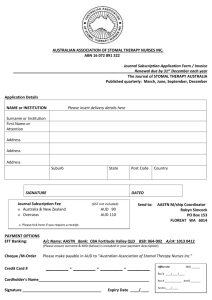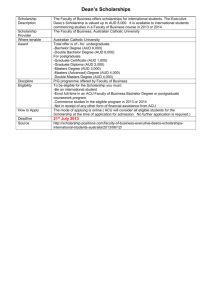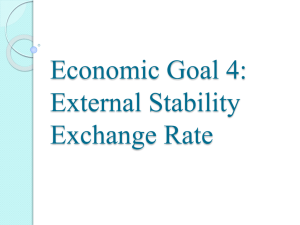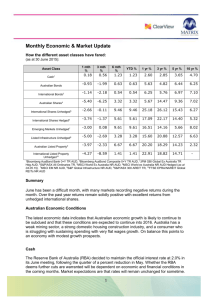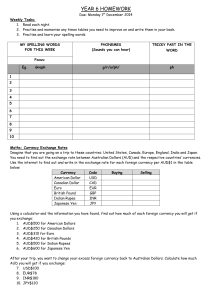Central Bank Holdings of Australian Dollars
advertisement
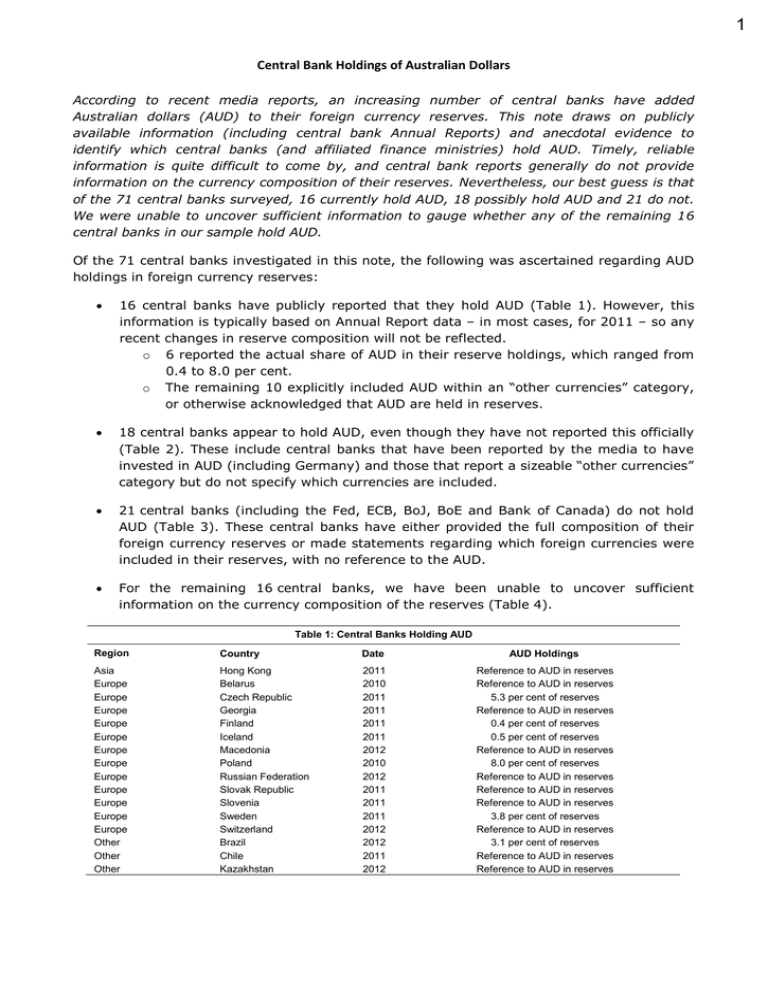
1 Central Bank Holdings of Australian Dollars According to recent media reports, an increasing number of central banks have added Australian dollars (AUD) to their foreign currency reserves. This note draws on publicly available information (including central bank Annual Reports) and anecdotal evidence to identify which central banks (and affiliated finance ministries) hold AUD. Timely, reliable information is quite difficult to come by, and central bank reports generally do not provide information on the currency composition of their reserves. Nevertheless, our best guess is that of the 71 central banks surveyed, 16 currently hold AUD, 18 possibly hold AUD and 21 do not. We were unable to uncover sufficient information to gauge whether any of the remaining 16 central banks in our sample hold AUD. Of the 71 central banks investigated in this note, the following was ascertained regarding AUD holdings in foreign currency reserves: 16 central banks have publicly reported that they hold AUD (Table 1). However, this information is typically based on Annual Report data – in most cases, for 2011 – so any recent changes in reserve composition will not be reflected. o 6 reported the actual share of AUD in their reserve holdings, which ranged from 0.4 to 8.0 per cent. o The remaining 10 explicitly included AUD within an “other currencies” category, or otherwise acknowledged that AUD are held in reserves. 18 central banks appear to hold AUD, even though they have not reported this officially (Table 2). These include central banks that have been reported by the media to have invested in AUD (including Germany) and those that report a sizeable “other currencies” category but do not specify which currencies are included. 21 central banks (including the Fed, ECB, BoJ, BoE and Bank of Canada) do not hold AUD (Table 3). These central banks have either provided the full composition of their foreign currency reserves or made statements regarding which foreign currencies were included in their reserves, with no reference to the AUD. For the remaining 16 central banks, we have been unable to uncover sufficient information on the currency composition of the reserves (Table 4). Table 1: Central Banks Holding AUD Region Country Date AUD Holdings Asia Europe Europe Europe Europe Europe Europe Europe Europe Europe Europe Europe Europe Other Other Other Hong Kong Belarus Czech Republic Georgia Finland Iceland Macedonia Poland Russian Federation Slovak Republic Slovenia Sweden Switzerland Brazil Chile Kazakhstan 2011 2010 2011 2011 2011 2011 2012 2010 2012 2011 2011 2011 2012 2012 2011 2012 Reference to AUD in reserves Reference to AUD in reserves 5.3 per cent of reserves Reference to AUD in reserves 0.4 per cent of reserves 0.5 per cent of reserves Reference to AUD in reserves 8.0 per cent of reserves Reference to AUD in reserves Reference to AUD in reserves Reference to AUD in reserves 3.8 per cent of reserves Reference to AUD in reserves 3.1 per cent of reserves Reference to AUD in reserves Reference to AUD in reserves Table 2: Central Banks Possibly Holding AUD Region Country Evidence of AUD Holdings Major economy China Anecdotal evidence* Major economy France Anecdotal evidence* Major economy Germany According to media reports* Asia India Large “Other Currencies” Category Asia Indonesia According to media reports* Asia Israel According to media reports* Asia Malaysia Large “Other Currencies” Category* Asia Philippines Large “Other Currencies” Category Asia Singapore Diversified range of FX assets* Asia South Korea According to media reports* Asia Thailand According to media reports* Asia Vietnam According to media reports Europe Austria Anecdotal evidence* Europe Lithuania Large “Other Currencies” Category Europe Romania Large “Other Currencies” Category Other Jordan Large “Other Currencies” Category Other Peru Large “Other Currencies” Category Other South Africa Large “Other Currencies” Category * The Dealing Room believes these countries hold AUD reserves Table 3: Central Banks Not Holding AUD Region Major economy Major economy Major economy Major economy Major economy Asia Europe Europe Europe Europe Europe Europe Europe Europe Europe Europe Other Other Other Other Other Country Canada European Central Bank Japan United Kingdom United States New Zealand Denmark Hungary Ireland Italy Latvia Luxembourg Malta Moldova Netherlands Norway Armenia Colombia Mexico Morocco Tunisia 2 Table 4: Central Banks with Unknown Foreign Currency Reserves Region Country Europe Europe Europe Europe Europe Europe Europe Europe Europe Europe Other Other Other Other Other Other Belgium Bulgaria Croatia Cyprus Estonia Greece Portugal Spain Turkey Ukraine Argentina Costa Rica Ecuador Egypt El Salvador Uruguay Market Analysis Section 3 August 2012 3 2 From: Sent: To: Cc: Subject: Monday, 13 August 2012 10:20 AM RE: Central Bank Holdings of Australian Dollars [SEC=UNCLASSIFIED] Hi We’ve been unable to uncover any official announcements from these Middle Eastern countries regarding their holdings of Australian dollars. However, based on their relatively large holdings of FX reserves and the media reports below, we would classify UAE, Saudi Arabia, Qatar and Kuwait as countries possibly holding AUD. The composition of Iran’s FX reserves, on the other hand, would most likely be classified as “unknown” We will follow this up with http://press/summary/views/external/pdf/00157368852/ http://blogs.wsj.com/dealjournalaustralia/2012/06/14/germany-is-late-to-the-aussie-bond-party/ Regards, | Analyst | Market Analysis, International Department RESERVE BANK OF AUSTRALIA | 65 Martin Place, Sydney NSW 2000 | w: www.rba.gov.au From: Sent: Tuesday, 7 August 2012 8:45 AM To: Cc: Subject: RE: Central Bank Holdings of Australian Dollars [SEC=UNCLASSIFIED] Thanks, and Very useful. Did you looks at the Middle East and SWF? (There is an article on page 3 of the AFR if you haven’t seen it yet.) From: Sent: Friday, 3 August 2012 5:47 PM To: Cc: ID Market Analysis Subject: Central Bank Holdings of Australian Dollars According to recent media reports, an increasing number of central banks have added Australian dollars (AUD) to their foreign currency reserves. This note draws on publicly available information (including central bank Annual Reports) and anecdotal evidence to identify which central banks (and affiliated finance ministries) hold AUD. Of the 71 central banks surveyed, 16 currently hold AUD, 18 possibly hold AUD and 21 do not. We were unable to uncover sufficient information to gauge whether any of the remaining 16 central banks in our sample hold AUD. 1 Regards, | Analyst | Market Analysis, International Department RESERVE BANK OF AUSTRALIA | 65 Martin Place, Sydney NSW 2000 | w: www.rba.gov.au 2 3 Is The Australian Dollar Overvalued? The A$ is around its highest level since 1985 in nominal TWI terms and its highest level since 1974 in real TWI terms. • Against the US$ and RMB, the A$ is 5-6 per cent below its post-float highs (reached in July 2011 and April 2011, respectively); • Against the euro, the A$ is at its highest level since the euro’s inception. Australian Dollar TWI Australian Dollar Post-float average = 100 Index, Yen US$, Euro Index Index 190 190 160 160 Euro per A$ (RHS)* 1.2 200 TWI (LHS)** 150 0.9 US$ per A$ (RHS) Real TWI Nominal TWI 130 130 100 100 0.6 100 Yen per A$ (LHS) 50 1984 70 1970 0.3 1988 1992 1996 2000 2004 2008 2012 70 1977 1984 1991 1998 2005 2012 Sources: ABS; RBA; Thomson Reuters; WM/Reuters * Deutsche Mark splice for observations prior to 1999 ** Indexed to post-float average = 100 Sources: Bloomberg; RBA; Thomson Reuters; WM/Reuters Currently, the high A$ is probably a bit above the level justified by fundamentals, given the recent decline in the terms of trade and deterioration in the global economic outlook. However, it is not clear that the A$ is substantially overvalued: • The terms of trade still remain high, despite having fallen by “more than 10 per cent” (as characterised in the SMP) from their Sep Q 2011 peak (more updated projections suggest a 15 per cent fall to Sep Q 2012). Note that this fall has been exacerbated by the unwinding of the effect of natural disasters on Australian export prices (most notably coal prices). • The recent experience of the A$ is not unique. It has performed roughly in line with comparable currencies (NZD, CAD) and has modestly underperformed global equity markets over 2012 to date, notwithstanding the euro’s depreciation and declines in global commodity prices. Australian Dollar and Other Assets* Over 2012 to-date % % *Against US dollar or in US dollar terms, except for EuroStoxx RBA ICP Euro -10 CRB Index -10 Westpac ICP -5 EM currencies -5 AUD 0 Canadian dollar 0 NZ dollar 5 Euro Stoxx 5 MSCI World 10 S&P 500 10 Most models that we tend to focus on suggest the A$ could be 4-15% overvalued (Table 1, graphs for RBA models). • In the RBA models, the exchange rate lies within or just outside a 1 standard deviation (st dev) band around the ‘equilibrium’ estimate. All are within 2 st devs but the nature of exchange rate modelling is such that a +/- 2 st dev band is very wide. • The results can differ according to model specification and sample period, but none point to substantial overvaluation (particularly given the uncertainty regarding such estimates). • RBA’s models are based on the long-run relationship between the real exchange rate and the terms of trade, and usually also the real policy rate differential with the G3. − Model 1 – from 1971 – A$ is 19-23% undervalued. This highlights the sensitivity of the results to the sample period used. − Model 2 – from 1986, the preferred model – A$ is 4-6% overvalued. (Note – expected growth differentials and relative risk premia may not be adequately captured by the variables already included in the model. The latter issue may be particularly problematic of late). − Model 3 – from 2002 – A$ is 12-13% overvalued. The coefficients are more heavily influenced by short term shocks – such as the transitory terms of trade spike in 2011 – which foreign exchange rate markets may have ‘looked through’. Accordingly, the standard deviation band is also wider. • Some other external models (e.g. those produced by the IMF and The Economist’s Big Mac Index) also suggest the real exchange rate is slightly overvalued. • The Economist Intelligence Unit’s Worldwide Cost of Living Index suggests it is currently 47 per cent more expensive for executives to live in Sydney than in New York. This may be interpreted as an overvaluation of the exchange rate, as it appears to be an absolute PPP-type measure using comparable baskets. However, the index is largely comprised of non-tradeable prices that can diverge permanently across economies and therefore cannot be interpreted as an estimate of ‘fair value’. Furthermore, New York appears to be a relatively cheap city by this measure and the 47 per cent figure would be smaller if a wider comparison was made. Table 1: Models of the Australian Dollar -- Summary Estimated exchange rate valuation Under/over—valuation Per cent deviation Standard deviations RBA Models Terms of trade only From 1971 (Model 1) From 1986 From 2002 Under Over Over 19*–23 4–6* 12 1.1–1.2 0.5–0.9 1.4 Adding real interest rate diffΔ From 1986 (Model 2) From 2002 (Model 3) Over Over 4–6* 13 0.5–0.9 1.4 External Models 5–15 IMF Models Over Big Mac Index (PPP model) Over 8 Δ Model from 1971 assigns the wrong sign to the real interest rate differential coefficient and is therefore omitted * Indicates result for model including a dummy variable capturing the portfolio shift in demand for A$ denominated assets from 2000–2002 2 The Treasury, in its recent Roundup article on the Australian dollar, reported an overvaluation range of 11-35% (see Attachment). However they conclude the following regarding these estimates: • ‘Thus, while estimates suggesting that the real exchange rate is above its medium-tolong term equilibrium may provide information about the likely direction of the exchange rate over an extended period of time, they need not imply that its current level is undesirably high, nor that intervention is warranted.’ (our emphasis) RBA forecasts suggest the equilibrium exchange rate could be around 1–4% lower in two years’ time (but still well within a 2 standard deviation band of the current exchange rate). • The forecasts reflect projected further declines in the terms of trade. While expectations should already be reflected in the current level of the exchange rate (or incorporated in expectations about domestic versus foreign inflation), it is unclear how much these expectations are already incorporated in the current estimate of the equilibrium. • These forecasts could provide a more long-run view about the equilibrium exchange rate, which is potentially more comparable with other models (PPP, some IMF models) that take a more long-run approach. Model 1 Model 2 'Equilibrium' Real Exchange Rate 'Equilibrium' Real Exchange Rate Model 1 excl. dummy variable, post-float average real TWI = 100 Model 2 excl. dummy variable, post-float average real TWI = 100 Index Index Index Index Forecast Forecast 220 220 140 'Equilibrium' term* 160 140 (+/- 1 std. dev. of historical long-run deviations) Observed real TWI Observed real TWI 160 'Equilibrium' term* (+/- 1 std. dev. of historical long-run deviations) 100 100 100 100 Based on market forecasts** Terms of trade coefficient = 0.99 40 1971 Terms of trade coefficient = 0.66 40 1977 1983 1989 1995 2001 2007 2013 60 1985 Based on market forecasts** 60 1989 1993 1997 2001 2005 2009 2013 * forecast based on RBA terms of trade forecast and constant cash rate ** Market forecasts of the terms of trade and the cash rate * forecast based on RBA forecasts ** Market forecasts of the terms of trade and the cash rate Model 3 'Equilibrium' Real Exchange Rate Model 3 excl. dummy variable, post-float average real TWI = 100 Index Index Forecast 'Equilibrium' term* 130 (+/- 1 std. dev. of historical long-run deviations) 130 100 100 Observed real TWI Terms of trade coefficient = 0.58 70 2002 2004 2006 2008 2010 Based on market forecasts** 70 2012 2014 * forecast based on RBA terms of trade forecast and constant cash rate ** Market forecasts of the terms of trade and the cash rate 3 ATTACHMENT: Treasury Roundup Article The Treasury reported an overvaluation range of 11-35% based on estimates of the long-run equilibrium for the exchange rate. Note: • These estimates exclude cyclical and, in the case of the PPP models, even structural factors (whereas the RBA estimates are based on more current fundamentals that include cyclical elements) − Treasury notes there are ‘many reasons to question the validity of PPP-based estimates’. • The results for the IMF models shown below are quite dated – October 2011. The most recent IMF results are for June 2012 and are given in our table above. − Furthermore, Treasury notes the IMF results are not statistically significant and do not ‘take into account cyclical divergences in economic activity and relative interest rates’. Quotes from the article: On intervention: ‘Even if sterilised intervention was effective in lowering the exchange rate, the same problem of incompatible policy objectives would still arise. If the central bank continued to target inflation, it would need to offset the stimulatory effect of the lower exchange rate by raising interest rates, which would in turn tend to push the exchange rate back up. This is why decisions on intervention are appropriately a matter for the RBA.’ p52 ‘While the RBA does not take a completely ‘hands off’ approach to the exchange rate, it nowadays intervenes only during periods of market dysfunction (RBA 2011).’ p52, footnote 9. (Note the referenced RBA Bulletin article only stated that we had recently intervened because of market dysfunction, but was careful not to make any policy statements about why we may or may not intervene in the future. Last year’s Annual Report was similarly cautious in its wording, noting that foreign exchange intervention ‘tends to be specific to the particular episode’. This year’s Annual Report says ‘the Bank retains discretion to intervene to address dislocated markets and gross misalignments of the exchange rate’.) 4 ‘As the current challenges faced by the Australian economy are quite different to those faced by the Swiss, there is no coherent reason for the RBA to follow the lead of the SNB and lower the value of the AUD. While the SNB’s approach is consistent with its mandate given its circumstances, adopting the same approach here would raise fundamental conflicts with the RBA’s inflation target.’ p56, Box 2 ‘As such, calls for Australia to shift away from its long-standing policy approach and take action directed at lowering the value of the AUD are misplaced. Rather than helping the economy, the available options are likely to be either ineffective or result in greater macroeconomic instability. The combination of flexible inflation-targeting monetary policy and a floating exchange rate has served Australia well in delivering macroeconomic stability through a range of shocks over the past two decades. There is no coherent reason to believe that it is inappropriate for current economic circumstances.’ p57 Specifically on monetary policy: ‘Should the exchange rate become too high for macroeconomic purposes, this will be reflected in rising spare capacity and, ultimately, declining inflation. In these circumstances we could expect that monetary policy would be eased, putting downward pressure on the exchange rate. Hence, the appropriate remedy for an excessively high exchange rate is already available within the existing inflation-targeting framework.’ p51 On fiscal policy: ‘The substantial fiscal consolidation currently under way, totalling 4½ per cent of GDP between 2009-10 and 2012-13, is already helping to moderate upward pressure on the AUD. Achieving a substantially lower exchange rate through this avenue would therefore require a much larger fiscal contraction than is appropriate given the global economic environment currently facing Australia.’ Market Analysis International Department 17 August 2012 5 4 Balance of Payments and International Investment Position — June Quarter 2012 Financial Account In contrast to the previous nine quarters, when net capital inflows to the public sector averaged 3.3 per cent of GDP, net flows were close to zero in the June quarter, reflecting: – An outflow of 0.7 per cent of GDP to the General Government sector (Graph 5); and The net outflow of capital from the general government sector may have been affected by a number of factors. While there was a small net maturity of Commonwealth Government securities (CGS) in the June quarter, a large bond matured and another large bond became due for maturity within a year’s time (which is a trigger for some investors – including some central banks - to roll out of these positions). This may have contributed to the capital outflow if foreign ownership of these bonds was particularly high and/or the holdings were not rolled over into new positions. 2 Despite the net outflow of capital from the general government sector, the total stock of foreign holdings of government securities increased during the quarter, owing to positive valuation effects associated with the fall in bond yields. Overall, foreign ownership of CGS fell slightly to 76.1 per cent in the June quarter (from 76.5 per cent in the March quarter). Graph 4 Graph 5 Australian Capital Flows General Government Portfolio Debt Flows* Net inflows, per cent of GDP Gross flows, per cent of GDP % % 10 10 5 5 5 0 0 0 % Quarterly Annual 10 10 Net inflow 2002 * 2004 2006 2008 2010 2012 Assumes all direct investment is private. Includes state government and public corporations, and adjusted for the US dollar swap facility in 2008 and 2009. Sources: ABS; RBA 2 5 Foreign investment in Australia 0 Australian investment abroad Current account deficit (s.a.) -5 -10 % General government Private and other* Official reserve assets Quarterly Annual -5 -5 -10 -10 -5 2002 2004 2006 2008 2010 2012 -10 * Excludes State government and public corporations. Sources: ABS; RBA One possible scenario is that some of the proceeds from these bond maturities or bond sales might have been held in cash prior to being reinvested / Market Analysis / International Department / Financial Conditions Section / Economic Analysis Department 4 September 2012
